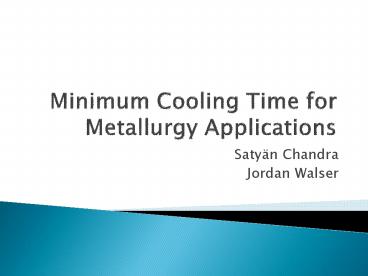Minimum Cooling Time for Metallurgy Applications - PowerPoint PPT Presentation
Title:
Minimum Cooling Time for Metallurgy Applications
Description:
... 1_Concourse 2_Concourse 3_Concourse 4_Concourse 5_Concourse 6_Concourse 7_Concourse Minimum Cooling Time for Metallurgy Applications Introduction: ... – PowerPoint PPT presentation
Number of Views:39
Avg rating:3.0/5.0
Title: Minimum Cooling Time for Metallurgy Applications
1
Minimum Cooling Time for Metallurgy Applications
- Satyän Chandra
- Jordan Walser
2
Introduction Description
- Problem Focus Cooling of Heated Metals.
- Heated Aluminum cylinder left to cool
experiences - Conduction
- Free Convection
- Forced Convection
- Radiation
- Experimental and Analytical results compared.
3
Introduction Motivation
- Our goal in doing this project is
- To Validate Heat Transfer Principles and Theories
learnt in this class by comparing experimental
results to those obtained analytically using
equations and correlations of Heat Transfer. - To Support Safety and Safety Precautions by
identifying the minimum time needed for Aluminum
heated to its annealing temperature to cool down
to a level safe for direct contact. (This
objective is derived from several months of
working in the Materials Lab and observing
students burn their hands by touching Aluminum
that is very hot)
4
Problem Set Up
Tsur 22 C 295 K
T8 20 C 293 K
Surrounding Room Wall
At t 0 s Tcylinder 250 C 523 K
Cylinder
Air
qconvection
Safe to Operate Temperature for Humans 50 C
323 K T
qradiation
qconduction
Resting Table of Fire Clay Brick (K lt 1 W/m.
K)). Flux consists of Conductive, Convective and
Radiative components.
Cylinder on Table
5
Experimental Results
- Used K Type Digital Thermometer for measurement
of Cylinder Surface Temperature - Initial Cylinder Temperature 250 C
- Desired Cylinder Temperature 50 C
- Time (250 C 50 C) 1Hr. 40 Min
6
Analytical Results I
Dimensions
Aluminum
Air (359 K)
7
Analytical Results II
Find htot
8
Analytical Results III
Check Lumped Capacitance
Lumped Capacitance Satisfied
Solve for time to cool from 250 ? to 50
9
Conclusion of Experiment
Experimental Result Analytical Result Difference
14000 24521 40
1 Hour and 40 Minutes and 0 Seconds 2 Hours and 45 Minutes and 21 Seconds
- It takes almost 1 hour more theoretically for an
Aluminum Cylinder to cool that it does
experimentally. - The Experimental and Analytical methods compare
closely. Although the difference is 40, the
results are in the same range.
10
Analysis of Results
- The Experimental and Analytical Results vary
considerably. The following are reasons for the
disparity - Cylinder approximated as uniform. Actual Cylinder
was not uniform in Diameter. - Thermal Conduction through resting table ignored
due to ltlt thermal conductivity of Fire Brick. - The extent of Forced Convection was higher in
reality during heating of the room (Air gushing
into the room from vents). - Approximate Properties used at average
temperature (250 C 50 C)/2 - The Emissivity co-efficient did not consider
surface smoothness/ roughness of Al sample
cylinder.
11
Appendix Cylinder Pictures































